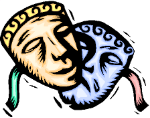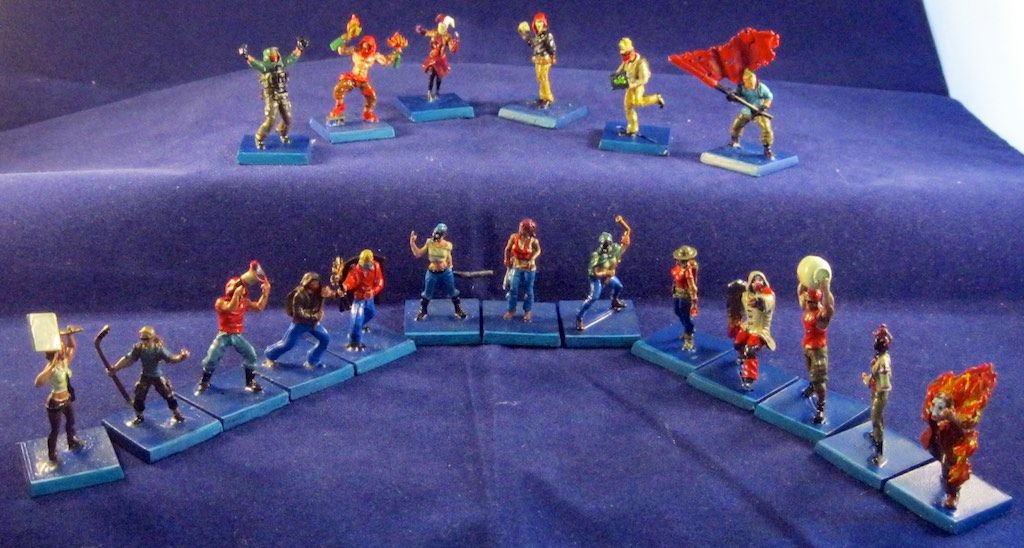Aetherium is set in a future world approximately 250 years from today (set in 2247). Scientists have discovered a way to access a virtual reality which has mostly replaced other venues for trade, entertainment, and even governing and work. Most people flee the dystopian future "real world" for the virtual world which is more "real" than the non-virtual. It's a place that is no place. It's the Aetherium.
The background of this game grabs ideas from several tropes endeared to many similar in age and interests to me. Tron, Ready Player 1, the Matrix, and aspects of Inception all flavor this game world. There are also incredibly strong cyberpunk aspects that could have been inspired from Shadowrun or Cyberpunk the role playing games. This game doesn't just rest on nostalgia but also delivers an incredibly solid game system to play within. It combines miniatures and board game elements with that solid ruleset to grab and pull you into it's world.
The Basics
Aetherium is a miniature board game which combined aspects of table-top miniature wargaming with feature and constraints of a traditional board game. Two players each use their forces, named Collectives, to achieve objectives on a game board. Collectives are constructed by selecting specific 3 to 5 programs which are represented by 28mm models. The models are provided unpainted and need to be assembled and painted for best results.- Game: Aetherium
- Company: Anvil-8 Games
- Website: http://www.anvil-eight.com/
- Players: 2
- Play time: typically 60 minutes
How's it play? (shortly)
Aetherium is setup with a dual layer playing board to represent the virtual space in the A.E.T.H.E.R that the two collectives will be struggling over. The base layer of the board is a 30x30 inch grid board made of the same material used for mouse pads. This mat represents the Quantum Noise, the background environment of the Aetherium which is dangerous for programs to enter. On this mat are set a number of tiles representing the "safe" environments within the quantum noise. These smaller tiles (called schema) are 5x5, 7x7, and 9x9 grids which are setup by the players at the beginning of the game. This initial set-up is part of the game strategy, but is not a fixed location for the schema. There is a mechanic during the game where each player can move schema around the quantum noise mat to gain advantages.Following the schema setup each player will deploy any Nodes or Pylons required for the mission being played. Nodes are naturally occurring "anchors" which each faction is trying to gain control of. Pylons are faction specific man-made anchors, less powerful than Nodes but still point's of control for each faction to try to take. Players then deploy the programs in their collectives and begin to play the game. Play proceeds with each player working their way through their PAD (Program Activation Deck), a deck of cards which determines the order each players programs activate. Once the PAD is exhausted a player will be able to reset their PAD, selecting the new order of program activation for the next turn.
Programs will use a limited resource known as CS to take actions including moving around the board, utilizing special abilities, or gaining control of a pylon or node. The schema have terrain on them, indicated by icons on the boards, which will block line of sight, provide cover, and hamper movement across certain spaces. Each program will also have the ability to attack for "free" as part of their activation.
There is one other aspect of the game and resources which players need to keep track of. This is the RAM resource, which affects the game in a number of ways. First, RAM can be used to "overpower" a program, converting RAM into CS for additional actions up to a programs OC value. RAM can also be used to shift and rotate schema during a programs activation. This aspect fully incorporates the game board into the game in a way that's makes it a key component of each players strategy and tactics.
Who are the forces?
Aetherium represents the conflicts that arise in a future digital realm known as the A.E.T.H.E.R between multiple factions who are accessing and in some cases trying to control that realm. At game launch (2015) there are two factions available for players to use. Nearly half of these factions are available in the 2-player starter set, with the additional programs available for sale on the Anvil-8 web store. Listeners to Gamers Lounge episode 108, episode 97, and Gamers Lounge Interview - Aetherium have heard some of the future factions planned. At this time the Nanomei and Axiom are available, with the Ikaru being officially unveiled at Gencon 2015.Axiom
The Axiom fill roles as both the government and the state religion in the world of Aetherium. The Axiom emerged from the chaos of the trade wars and has established order where the average citizen of the real world and the Aetherium has the freedom to obey. Although the Axiom would prefer to establish and maintain order via compliance and strong propaganda, they are not afraid to enforce that order via force.These tenants find their way into the game play of the programs in the faction very cleanly. The Axiom has very efficient programs, utilizing an average amount of CS (action points) with very small OC (Over clock) values. The majority of their programs focus on absorbing damage and manipulating enemy programs on the board by pushing them around and relocating them on the board. The Axiom has key programs in the faction which can combine abilities to apply some terrific damage capabilities within the game.
Nanomei
The Nanomei are a faction of anarchists who rebel against the tight-fisted rule of the corporations who are trying to establish control of the Aetherium. The Nanomei bring their abilities into the virtual world and wage a constant battle against the forces that wish to control mankind and remove the choices for freedom. Nanomei programs exemplify this in a game play style focused on damage. Nanomei also has a lot of abilities which allow the use of fire both as a "burnout" affect on enemy models and by creating virtual "firewall" terrain on the board. Nanaomei programs tend to have moderate CS values but higher OC values, leading to a less efficient program overall, with abilities to burst their effectiveness.What's innovative or different? What's fun?
Overall quality of the game
Aetherium is Anvil-8's first game, and this is not evident anywhere in the game. The quality of the boards, mat, rulebook, and box is equal to any other game currently produced by a major board game company in the market today. The rules are incredibly clean with very few questions after reading the rulebook and playing the game. The very limited rules questions that may come up are addressed in a 1 page FAQ on the Anvil-8 website. I was shocked by the quality of the rules for a first time production.The models used in this game are better than the "expected" board game quality miniatures. They rival table-top wargaming models, achieving a mid-field mini quality overall. The models are cast in resin and will require some basic modeling skills to assemble. This is likely to be a turn-off to "pure" board gamers, but should provide no challenge for anyone who also plays mini-games. The only complaint I have on the models is the amount of mold release which needs to be scrubbed off in order for the glue and paint to adhere to the model. Furthermore, the game benefits tremendously from painted models over plain grey resin.
Game Innovation and Draw
Aetherium has some fantastic portions of the overall game design that really pull together for a highly enjoyable game. The interaction between unit action points (CS), unit abilities, and the ability to add action points via the RAM/OC aspect provides multiple axis of resource management without becoming too complicated. The console board provided for each player makes tracking resources and choosing how to utilize those resource very straight forward.The Program Activation Deck allowing for a fixed order of unit activation each turn while adding in the aspect of reordering that activation between turns is very cool. This adds in an aspect of anticipation and bluffing with your opponent, where each player is trying to determine the order of their opponents program activation in the hopes of getting a "jump" on key units.
These two aspects combine with the models and units of the game to create a very dynamic and exciting play experience. This is further enhanced by the most innovative portion of the game, which is the schema manipulation. The ability to use RAM to shift and rotate the actual game board is one of the most exciting and tactical portions of this game. There is potential for the board at the end of the game to look completely different to how it looked at game start. This aspect adds a whole new dimension of tactical thought into how you approach facing off with your opponent. There is a whole new depth of tactics based on what Schema you control versus your opponent versus which are neutral and can be manipulated by both players. This also adds additional importance to managing your RAM resource, both to advance your own strategy and to counter your opponents shifting of schema.
Recommendation and thoughts
If it is not clear at this point of the review I will be very direct with my thoughts. I love this game and rate it very highly among my chosen games. Aetherium has quickly become one of my favorite games in my collection, and I consider it one of my prime games to play. Aetherium is one of the best tactical mini games on the market, in addition to being a great gateway for traditional board gamers.The one weakness I see in the game is the current lack of distribution. Anvil-8 is a new game company and this is their first game, creating tough barriers to distributors picking up their game. This limits the exposure Aetherium needs to truly build the following it 's quality deserves.
Overall, I highly recommend this game.














